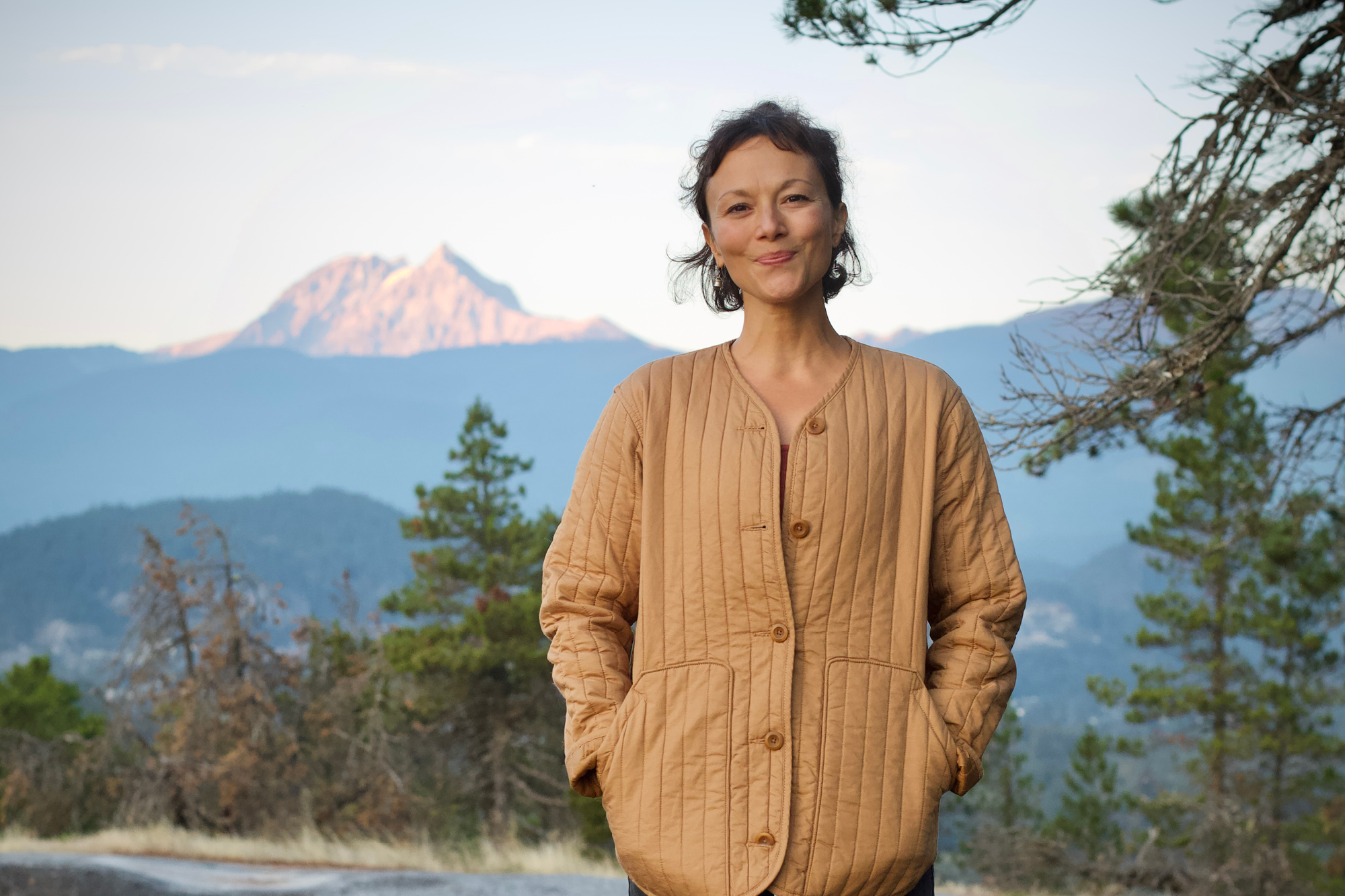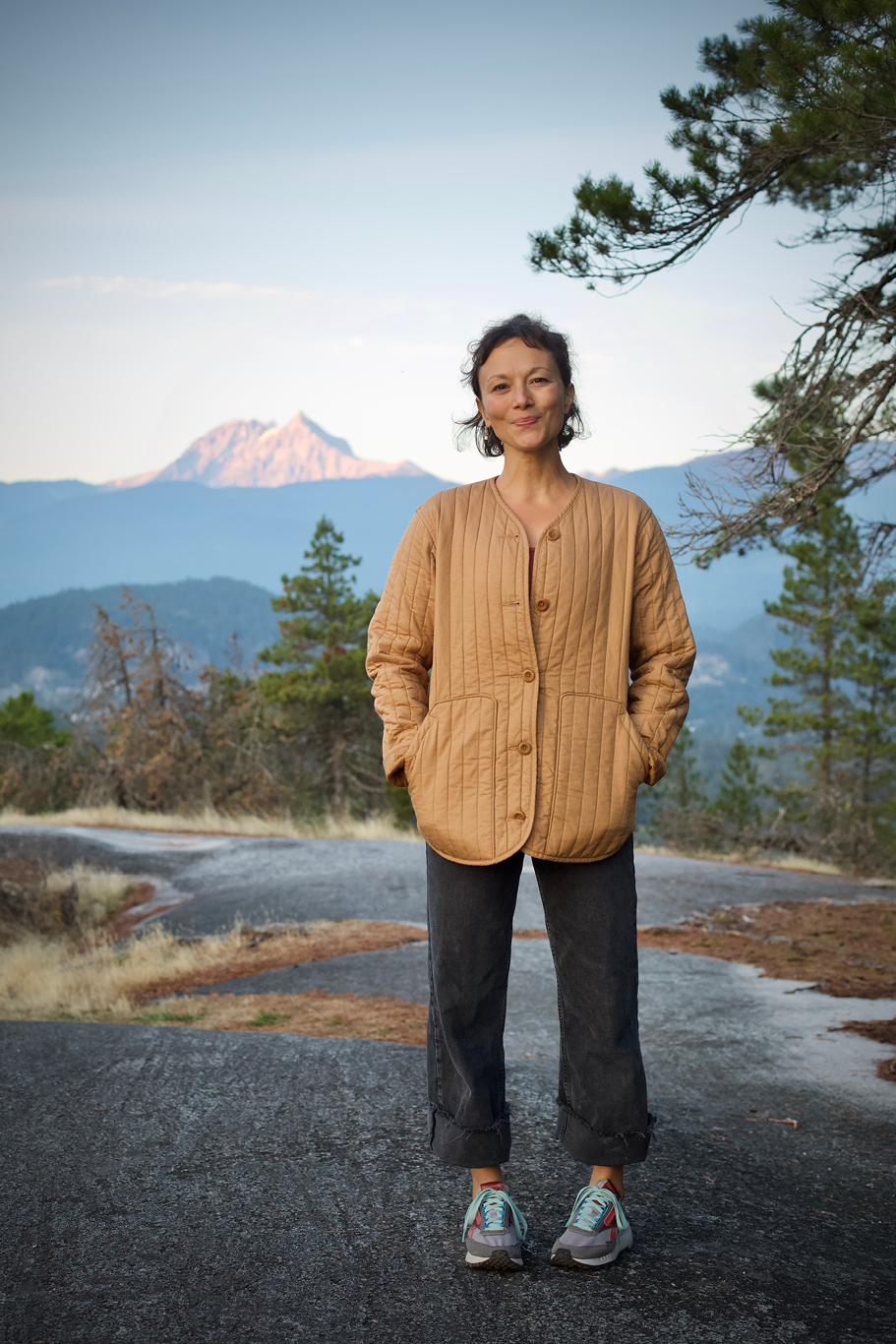Illuminated by a beam of light, Lydia Zamorano shifts from a tabletop position, back into a gentle child’s pose.
“Go to wherever you can go,” she says. “If it works for your knees, you can shift them a little wider. How does it feel to walk your hands forward, into a child’s form?”
She’s inviting you to practice, but you aren’t physically together. You’re in your own space, and she’s in a quiet, minimalist studio, guiding you through one of her online video classes.
“Here, some of us might stay up a little higher,” she explains, lengthening and stretching her child’s pose into a deeper forward fold.
“That’s okay. All of these movements are equal in value.”
Sensation in movement
Lydia Zamorano grew up in motion. In wild, mountainous interior BC, she was always exploring the landscape, through adventurous sports like snowboarding and rock climbing.
“As a teenager, I was always filling my time with athletic pursuits, moving at a really fast pace,” she remembers. “Those practices were an incredible way to connect to the land. But yoga was balancing for me, because it helped me slow down.”
Lydia was drawn to yoga not out of a desire for greater strength, flexibility, or athletic mastery. For her, it was about sensation — an introduction to practices of embodiment.
She first encountered yoga in a physical education class. Through a Yoga Nidra-style relaxation sequence, she tuned in to different parts of her body, while moving through a guided visualization.
“I came out of that completely changed,” she says. “I think that was the first time I felt fully relaxed. Feeling fully into my body was just so potent for me.”
This was nearly two decades ago, long before yoga hit the Western mainstream. As Lydia immersed herself in her new practice, books were the main source of education, and Ashtanga the prevailing style.
“It was freedom for me,” she says. “I’d hop in my car and drive two hours, each way, so I could take an in-person class.”

Yoga for connected lives
Movement is still central to Lydia’s life. Most days, she wakes up an hour before her children to practice; sometimes alone, sometimes to record and share with her community.
“In the earlier years of practice, before I had kids, I felt really rigid about it,” she shares. “Almost like I needed it to function. It was just so supportive for me, for so long.”
But through the transformative experiences of entrepreneurship and motherhood, Lydia has evolved how she moves. Her practice has become flexible and adaptive, without compromising her commitment to the discipline of yoga. On days that an early-morning session isn’t possible, she’ll often practice at night, sometimes even a Yin sequence in bed.
“I had bigger realizations of what yoga is really about,” she explains. “The art of relationships, the art of connection. I started to feel how I could have these moments of practice while I’m in service to my children, or connecting with my family.”
“Both my kids have grown up watching me practice, so they love it,” she continues. “My daughter often wants to practice with me. It’s not the same experience, obviously; they’ll crawl all over me! It’s more playful. It’s a bit more of a game. That sense of play is definitely another face in my practice. It’s another way to engage in embodied movement. ”
For Lydia, online practice is a way to help others discover this fluid, flexible way to move. She shares online practices through her subscription website, and her video classes with Movement by NM. Many of her videos are much shorter than a typical in-person class — often as little as ten to fifteen minutes.
“I’m really committed to delivering these practices for parents, entrepreneurs, folks whose lives are so full,” she says. “These shorter sequences, done regularly, can have a lasting, positive impact on the nervous system. That’s why I’m so committed to the online medium.”

A self-trusting style of practice
Lydia believes movement should be uniquely your own — guided by both the internal cues of your body, and the external cues of your lifestyle.
That’s why when she discovered trauma-sensitive and pain care aware teaching, they resonated with her so strongly.
“When I started being introduced to teachers who allowed you to choose a little more, to move through your own practice, I just felt so much relief,” she recalls. “That was the beginning of really creating my own practice, that suits me.”
Trauma-informed yoga is radically different from the aspirational, form-focused Ashtanga Vinyasa style Lydia first entered yoga through. Instead, the emphasis is on each individual’s control over their own body.
For Lydia, this form of practice was a revelation.
Instead of relying on external cues, like the teacher’s approval or the shape their body physically takes, students are given options and choices for each pose, and are encouraged to focus on their own experience and sensations. Empirically validated as a treatment for complex PTSD, trauma-informed yoga is empowering for just about anyone — emphasizing the studen’ss knowledge of, and control over, their own body.
To further develop her new interest, she completed training in paincare aware yoga. This style of teaching and cueing is designed to be more supportive to people experiencing injury-related and chronic pain.
All of us deal with pain sometimes, and a large number of people have chronic pain; 8 million Canadians, and 50.2 million of US adults. By checking in with — and trusting — your body’s own cues, these awareness-centred practices make yoga a more safe, inclusive and empowering space for people of all abilities and skill levels.
“In a yoga class, you’ve probably heard someone say, if you have pain here, don’t do this,” she explains. “That sends a certain message; almost that if someone has pain, maybe they shouldn’t be there.”
Instead, pain care aware yoga is informed by current pain science research. “It’s very similar to trauma-informed yoga, because you’re checking in with your feelings, asking, am I okay here? Can I bump into this sensation, and decide for myself?”
“That’s one of the incredible things about yoga to me — that it’s so far-reaching,” she reflects. “However I’m feeling, I can pull something out of my toolbox that will support me, whether I need to slow down, burn energy, or rebalance my system.”

Make it yours
“It’s so important to me to have the container of being led by someone skilled, but also honour that I’m in charge of my body, and I’m the one who knows my body best,” Lydia muses.
“That’s why I love saying in my practices, make it your own, make it yours. If we look at children learning things, they try, they tumble and they fall. That messiness is welcome. It doesn’t always have to be tidy.”







